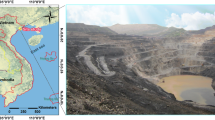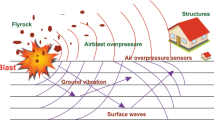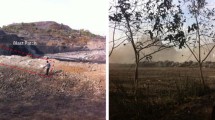Abstract
Blasting is the most popular method for rock fragmentation in open-pit mines. However, the side effects caused by blasting operations include ground vibration, air overpressure (AOp), fly rock, back-break, dust, and toxic are the critical factors which have a significant impact on the surrounding environment, especially AOp. In this paper, a robust artificial intelligence system was developed for predicting blast-induced AOp based on artificial neural networks (ANNs) and random forest (RF), code name ANNs-RF. Five ANN models were developed first; then, the RF algorithm was used to combine them. An empirical technique, ANN, and RF models were also developed to predict and compare with the ANNs-RF model. For this aim, 114 blasting events were recorded at the Nui Beo open-pit coal mine, Vietnam. The maximum explosive charge capacity, monitoring distance, vertical distance, powder factor, burden, spacing, and length of stemming were used as the input variables for predicting AOp. The quality of the models is evaluated by root-mean-square error (RMSE), determination coefficient (R2), mean absolute error (MAE), and a simple ranking method. The results indicated that the proposed ANNs-RF model was the most superior model with RMSE of 0.847, R2 of 0.985, MAE of 0.620 on testing dataset, and total ranking of 40. In contrast, the best ANN model yielded a slightly lower performance with RMSE of 1.184, R2 of 0.960, MAE of 0.809, and a total ranking of 39; the RF model yielded a performance with RMSE of 1.550, R2 of 0.939, MAE of 1.222, and total ranking of 22; the empirical model provided the lowest accuracy level with RMSE of 5.704, R2 of 0.429, MAE of 5.316 on the testing dataset, and total ranking of 6.










Similar content being viewed by others
References
Al Shalabi, L., Shaaban, Z., & Kasasbeh, B. (2006). Data mining: A preprocessing engine. Journal of Computer Science, 2(9), 735–739.
Amiri, M., Amnieh, H. B., Hasanipanah, M., & Khanli, L. M. (2016). A new combination of artificial neural network and K-nearest neighbors models to predict blast-induced ground vibration and air-overpressure. Engineering with Computers, 32(4), 631–644.
Armaghani, D. J., Hajihassani, M., Sohaei, H., Mohamad, E. T., Marto, A., Motaghedi, H., et al. (2015). Neuro-fuzzy technique to predict air-overpressure induced by blasting. Arabian Journal of Geosciences, 8(12), 10937–10950.
Armaghani, D. J., Hasanipanah, M., Amnieh, H. B., & Mohamad, E. T. (2018a). Feasibility of ICA in approximating ground vibration resulting from mine blasting. Neural Computing and Applications, 29(9), 457–465.
Armaghani, D. J., Hasanipanah, M., Mahdiyar, A., Majid, M. Z. A., Amnieh, H. B., & Tahir, M. M. (2018b). Airblast prediction through a hybrid genetic algorithm-ANN model. Neural Computing and Applications, 29(9), 619–629.
Armaghani, D. J., Hasanipanah, M., & Mohamad, E. T. (2016). A combination of the ICA-ANN model to predict air-overpressure resulting from blasting. Engineering with Computers, 32(1), 155–171.
Breiman, L. (2001). Random forests. Machine Learning, 45(1), 5–32.
Bui, X.-N., Nguyen, H., Le, H.-A., Bui, H.-B., Tran, Q.-H., & Long, N. Q. (2018). The outcome prediction of blast-induced air-blast overpressure in open-pit mine using empirical and several ensemble machine learning algorithms. Environmental Earth Sciences, 1–17.
Chai, T., & Draxler, R. R. (2014). Root mean square error (RMSE) or mean absolute error (MAE)?–Arguments against avoiding RMSE in the literature. Geoscientific Model Development, 7(3), 1247–1250.
Chandar, K. R., Sastry, V., & Hegde, C. (2017). A critical comparison of regression models and artificial neural networks to predict ground vibrations. Geotechnical and Geological Engineering, 35(2), 573–583.
Company, N. B. (2010). Summary report of production in 2010, Nui Beo (unpublish report).
Coursen, D. L. (1995). Method of reducing ground vibration from delay blasting. Google Patents.
de Moraes Takafuji, E. H., da Rocha, M. M., & Manzione, R. L. (2018). Groundwater level prediction/forecasting and assessment of uncertainty using SGS and ARIMA Models: A case study in the Bauru Aquifer System (Brazil). Natural Resources Research, 1–17.
Ebrahimi, E., Monjezi, M., Khalesi, M. R., & Armaghani, D. J. (2016). Prediction and optimization of back-break and rock fragmentation using an artificial neural network and a bee colony algorithm. Bulletin of Engineering Geology and the Environment, 75(1), 27–36.
Geranian, H., Tabatabaei, S. H., Asadi, H. H., & Carranza, E. J. M. (2016). Application of discriminant analysis and support vector machine in mapping gold potential areas for further drilling in the Sari-Gunay gold deposit, NW Iran. Natural Resources Research, 25(2), 145–159.
Gislason, P. O., Benediktsson, J. A., & Sveinsson, J. R. (2006). Random forests for land cover classification. Pattern Recognition Letters, 27(4), 294–300.
Hajihassani, M., Armaghani, D. J., Sohaei, H., Mohamad, E. T., & Marto, A. (2014). Prediction of airblast-overpressure induced by blasting using a hybrid artificial neural network and particle swarm optimization. Applied Acoustics, 80, 57–67.
Han, J., Pei, J., & Kamber, M. (2011). Data mining: Concepts and techniques. Amsterdam: Elsevier.
Hariharan, S., Tirodkar, S., Porwal, A., Bhattacharya, A., & Joly, A. (2017). Random forest-based prospectivity modelling of greenfield terrains using sparse deposit data: an example from the tanami region, western Australia. Natural Resources Research, 26(4), 489–507.
Hasanipanah, M., Amnieh, H. B., Arab, H., & Zamzam, M. S. (2018). Feasibility of PSO–ANFIS model to estimate rock fragmentation produced by mine blasting. Neural Computing and Applications, 30(4), 1015–1024.
Hasanipanah, M., Armaghani, D. J., Khamesi, H., Amnieh, H. B., & Ghoraba, S. (2016). Several non-linear models in estimating air-overpressure resulting from mine blasting. Engineering with Computers, 32(3), 441–455.
Hasanipanah, M., Shahnazar, A., Amnieh, H. B., & Armaghani, D. J. (2017). Prediction of air-overpressure caused by mine blasting using a new hybrid PSO–SVR model. Engineering with Computers, 33(1), 23–31.
Hustrulid, W. A. (1999). Blasting principles for open pit mining: General design concepts. Rotterdam: Balkema.
Kambouchev, N., Noels, L., & Radovitzky, R. (2006). Nonlinear compressibility effects in fluid-structure interaction and their implications on the air-blast loading of structures. Journal of Applied Physics, 100(6), 063519.
Khandelwal, M., & Kankar, P. (2011). Prediction of blast-induced air overpressure using support vector machine. Arabian Journal of Geosciences, 4(3–4), 427–433.
Khandelwal, M., & Singh, T. (2005). Prediction of blast induced air overpressure in opencast mine. Noise & Vibration Worldwide, 36(2), 7–16.
Koopialipoor, M., Armaghani, D. J., Hedayat, A., Marto, A., & Gordan, B. (2018a). Applying various hybrid intelligent systems to evaluate and predict slope stability under static and dynamic conditions. Soft Computing. https://doi.org/10.1007/s00500-018-3253-3.
Koopialipoor, M., Fallah, A., Armaghani, D. J., Azizi, A., & Mohamad, E. T. (2018b). Three hybrid intelligent models in estimating flyrock distance resulting from blasting. Engineering with Computers. https://doi.org/10.1007/s00366-018-0596-4.
Kuzu, C., Fisne, A., & Ercelebi, S. (2009). Operational and geological parameters in the assessing blast induced airblast-overpressure in quarries. Applied Acoustics, 70(3), 404–411.
Loder, B. National Association of Australian State Road Authorities. In Australian Workshop for Senior ASEAN Transport Officials, 1985, Canberra, 1987
Longjun, D., Xibing, L., Ming, X., & Qiyue, L. (2011). Comparisons of random forest and support vector machine for predicting blasting vibration characteristic parameters. Procedia Engineering, 26, 1772–1781.
Mahdevari, S., Shahriar, K., Sharifzadeh, M., & Tannant, D. D. (2017). Stability prediction of gate roadways in longwall mining using artificial neural networks. Neural Computing and Applications, 28(11), 3537–3555.
Mayorga, M. A. (1997). The pathology of primary blast overpressure injury. Toxicology, 121(1), 17–28.
McKenzie, C. (1990). Quarry blast monitoring: Technical and environmental perspectives. Quarry Management, 17, 23–24.
Mohamad, E. T., Armaghani, D. J., Hasanipanah, M., Murlidhar, B. R., & Alel, M. N. A. (2016). Estimation of air-overpressure produced by blasting operation through a neuro-genetic technique. Environmental Earth Sciences, 75(2), 174.
Mokhtari, M., & Behnia, M. (2018). Comparison of LLNF, ANN, and COA-ANN techniques in modeling the uniaxial compressive strength and static Young’s Modulus of Limestone of the Dalan formation. Natural Resources Research, https://doi.org/10.1007/s11053-018-9383-6.
Monjezi, M., Baghestani, M., Faradonbeh, R. S., Saghand, M. P., & Armaghani, D. J. (2016). Modification and prediction of blast-induced ground vibrations based on both empirical and computational techniques. Engineering with Computers, 32(4), 717–728.
Monjezi, M., Ghafurikalajahi, M., & Bahrami, A. (2011). Prediction of blast-induced ground vibration using artificial neural networks. Tunnelling and Underground Space Technology, 26(1), 46–50.
Nateghi, R., Kiany, M., & Gholipouri, O. (2009). Control negative effects of blasting waves on concrete of the structures by analyzing of parameters of ground vibration. Tunnelling and Underground Space Technology, 24(6), 608–616.
Ngo, T., Mendis, P., Gupta, A., & Ramsay, J. (2007). Blast loading and blast effects on structures–An overview. Electronic Journal of Structural Engineering, 7(S1), 76–91.
Nguyen, H., & Bui, X.-N. (2018). A comparison of artificial neural network and empirical technique for predicting blast-induced ground vibration in open-pit mine. In Mining sciences and technology—XXVI, Mong Cai, Hanoi, Vietnam, 2018 (pp. 177-182): Industry and trade of the socialist republic of Vietnam.
Nguyen, H., Bui, X.-N., Bui, H.-B., & Mai, N.-L. (2018a). A comparative study of artificial neural networks in predicting blast-induced air-blast overpressure at Deo Nai open-pit coal mine, Vietnam. [journal article]. Neural Computing and Applications, https://doi.org/10.1007/s00521-018-3717-5.
Nguyen, H., Bui, X.-N., & Tran, Q.-H. (2017). Prediction of blast-induced air overpressure in Deo Nai open-pit coal mine using Random Forest algorithm. Journal of Mining Industry, 06, 47–53.
Nguyen, H., Bui, X.-N., Tran, Q.-H., & Mai, N.-L. (2018b). A new soft computing model for estimating and controlling blast-produced ground vibration based on hierarchical K-means clustering and cubist algorithms. Applied Soft Computing, 1–20.
Nick, N. (2008). Joseph Juran, 103, Pioneer in quality control, Dies. New York Times, 3, 3.
Patterson, D. W. (1998). Artificial neural networks: Theory and applications. Upper Saddle River: Prentice Hall.
Pelletier, C., Valero, S., Inglada, J., Champion, N., & Dedieu, G. (2016). Assessing the robustness of Random Forests to map land cover with high resolution satellite image time series over large areas. Remote Sensing of Environment, 187, 156–168.
Perez, L. G., Flechsig, A. J., Meador, J. L., & Obradovic, Z. (1994). Training an artificial neural network to discriminate between magnetizing inrush and internal faults. IEEE Transactions on Power Delivery, 9(1), 434–441.
Rahimdel, M. J., Mirzaei, M., Sattarvand, J., Ghodrati, B., & Mirzaei Nasirabad, H. (2017). Artificial neural network to predict the health risk caused by whole body vibration of mining trucks. Journal of Theoretical and Applied Vibration and Acoustics, 3(1), 1–14.
Rezaei, M., Monjezi, M., & Varjani, A. Y. (2011). Development of a fuzzy model to predict flyrock in surface mining. Safety Science, 49(2), 298–305.
Roshanravan, B., Aghajani, H., Yousefi, M., & Kreuzer, O. (2018). Particle Swarm Optimization Algorithm for Neuro-Fuzzy Prospectivity Analysis Using Continuously Weighted Spatial Exploration Data. [journal article]. Natural Resources Research, https://doi.org/10.1007/s11053-018-9385-4.
Roy, S., Adhikari, G., Renaldy, T., & Jha, A. (2011). Development of multiple regression and neural network models for assessment of blasting dust at a large surface coal mine. Journal of Environmental science and Technology, 4(3), 284–301.
Sawmliana, C., Roy, P. P., Singh, R., & Singh, T. (2007). Blast induced air overpressure and its prediction using artificial neural network. Mining Technology, 116(2), 41–48.
Schalkoff, R. J. (1997). Artificial neural networks (Vol. 1). New York: McGraw-Hill.
Sikora, R., & Al-Laymoun, O. (2017). A modified stacking ensemble machine learning algorithm using genetic algorithms. In Information Resources Management Association (Ed.), Artificial intelligence: Concepts, methodologies, tools, and applications (pp. 395–405): IGI Global, Hershey.
Svetlov, S. I., Prima, V., Kirk, D. R., Gutierrez, H., Curley, K. C., Hayes, R. L., et al. (2010). Morphologic and biochemical characterization of brain injury in a model of controlled blast overpressure exposure. Journal of Trauma and Acute Care Surgery, 69(4), 795–804.
Swingler, K. (1996). Applying neural networks: A practical guide. Burlington: Morgan Kaufmann.
Tessema, A. (2017). Mineral systems analysis and artificial neural network modeling of chromite prospectivity in the Western Limb of the Bushveld Complex, South Africa. Natural Resources Research, 26(4), 465–488.
Todorovski, L., & Džeroski, S. Combining multiple models with meta decision trees. In European conference on principles of data mining and knowledge discovery, 2000 (pp. 54–64): Springer
Torres, V. N., Silveira, L. G., Lopes, P. F., & de Lima, H. M. (2018). Assessing and controlling of bench blasting-induced vibrations to minimize impacts to a neighboring community. Journal of Cleaner Production, 187, 514–524.
Vafaei, S., Soosani, J., Adeli, K., Fadaei, H., Naghavi, H., Pham, T. D., et al. (2018). Improving accuracy estimation of forest aboveground biomass based on incorporation of ALOS-2 PALSAR-2 and Sentinel-2A imagery and machine learning: A case study of the Hyrcanian forest area (Iran). Remote Sensing, 10(2), 172.
Witten, I. H., Frank, E., Hall, M. A., Pal, C. J., & Seeni, V. (2016). Data mining: Practical machine learning tools and techniques. Burlington: Morgan Kaufmann.
Yang, S., & Browne, A. (2004). Neural network ensembles: Combining multiple models for enhanced performance using a multistage approach. Expert Systems, 21(5), 279–288.
Zerguine, A., Shafi, A., & Bettayeb, M. (2001). Multilayer perceptron-based DFE with lattice structure. IEEE Transactions on Neural Networks, 12(3), 532–545.
Zuo, R., & Xiong, Y. (2018). Big data analytics of identifying geochemical anomalies supported by machine learning methods. Natural Resources Research, 27(1), 5–13.
Acknowledgments
This research was supported by Hanoi University of Mining and Geology (HUMG) and Ministry of Education and Training of Vietnam (MOET). We also thank the Center for Mining, Electro-Mechanical research of Hanoi University of Mining and Geology for supporting the instruments for data collecting.
Author information
Authors and Affiliations
Corresponding author
Rights and permissions
About this article
Cite this article
Nguyen, H., Bui, XN. Predicting Blast-Induced Air Overpressure: A Robust Artificial Intelligence System Based on Artificial Neural Networks and Random Forest. Nat Resour Res 28, 893–907 (2019). https://doi.org/10.1007/s11053-018-9424-1
Received:
Accepted:
Published:
Issue Date:
DOI: https://doi.org/10.1007/s11053-018-9424-1




